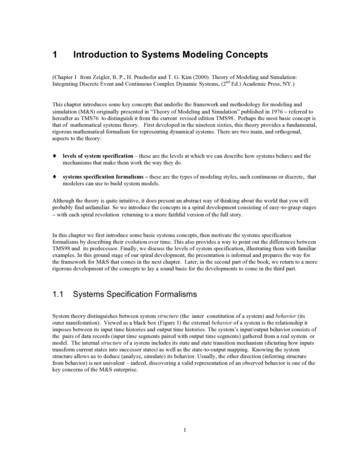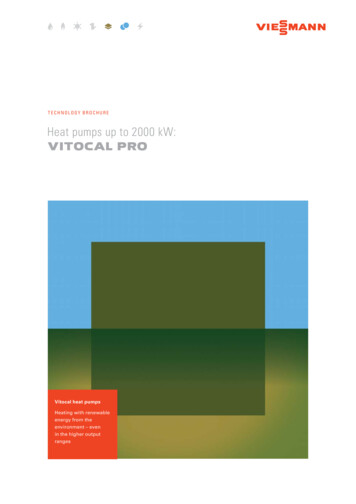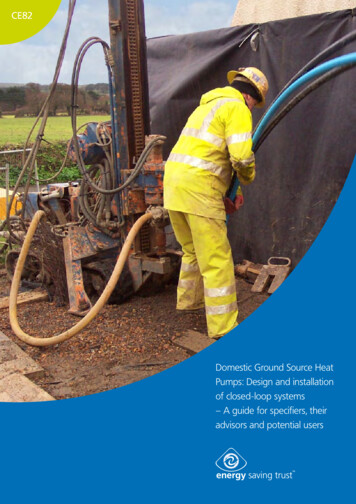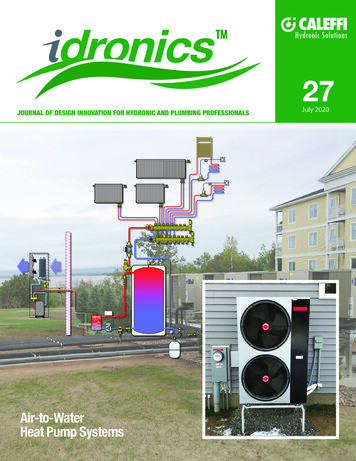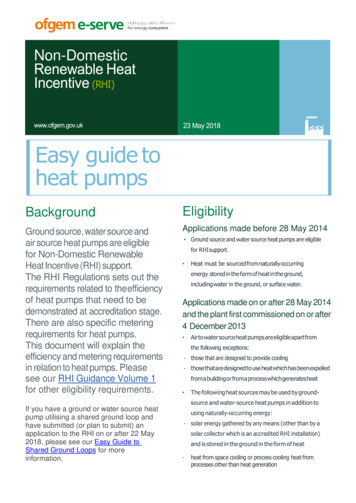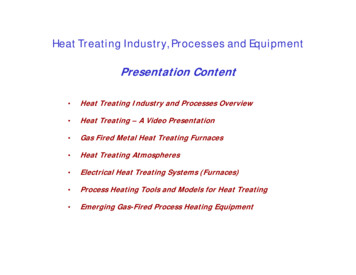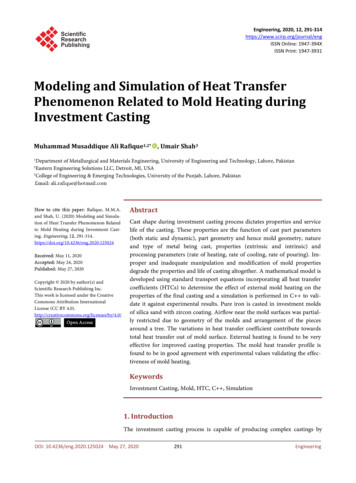
Transcription
Engineering, 2020, 12, 291-314https://www.scirp.org/journal/engISSN Online: 1947-394XISSN Print: 1947-3931Modeling and Simulation of Heat TransferPhenomenon Related to Mold Heating duringInvestment CastingMuhammad Musaddique Ali Rafique1,2* , Umair Shah3Department of Metallurgical and Materials Engineering, University of Engineering and Technology, Lahore, PakistanEastern Engineering Solutions LLC, Detroit, MI, USA3College of Engineering & Emerging Technologies, University of the Punjab, Lahore, Pakistan12How to cite this paper: Rafique, M.M.A.and Shah, U. (2020) Modeling and Simulation of Heat Transfer Phenomenon Relatedto Mold Heating during Investment Casting. Engineering, 12, eived: May 11, 2020Accepted: May 24, 2020Published: May 27, 2020Copyright 2020 by author(s) andScientific Research Publishing Inc.This work is licensed under the CreativeCommons Attribution InternationalLicense (CC BY en AccessAbstractCast shape during investment casting process dictates properties and servicelife of the casting. These properties are the function of cast part parameters(both static and dynamic), part geometry and hence mold geometry, natureand type of metal being cast, properties (extrinsic and intrinsic) andprocessing parameters (rate of heating, rate of cooling, rate of pouring). Improper and inadequate manipulation and modification of mold propertiesdegrade the properties and life of casting altogether. A mathematical model isdeveloped using standard transport equations incorporating all heat transfercoefficients (HTCs) to determine the effect of external mold heating on theproperties of the final casting and a simulation is performed in C to validate it against experimental results. Pure iron is casted in investment moldsof silica sand with zircon coating. Airflow near the mold surfaces was partially restricted due to geometry of the molds and arrangement of the piecesaround a tree. The variations in heat transfer coefficient contribute towardstotal heat transfer out of mold surface. External heating is found to be veryeffective for improved casting properties. The mold heat transfer profile isfound to be in good agreement with experimental values validating the effectiveness of mold heating.KeywordsInvestment Casting, Mold, HTC, C , Simulation1. IntroductionThe investment casting process is capable of producing complex castings byDOI: 10.4236/eng.2020.125024 May 27, 2020291Engineering
M. M. A. Rafique, U. Shahpouring metal into a mold, created as a result of melting and pouring out of waxpattern (dewaxing) from a ceramic coated body at high temperature [1]. Theshape left adopts the shape of casting. The wax pattern is formed at an earlierstage by injecting cold wax in a metal die precisely carrying the shape of part tobe casted. It is two-step replication process in which wax pattern and subsequently metal parts are produced [1]. The dimensional difference between thewax pattern and casted metal is due to the solidification shrinkage of metal, waxand shell molding materials. The differences between wax pattern and die, andbetween final part and shell, are known as shrinkage allowances of wax and metal, respectively. These allowances are considered during design and are important for successful investment casting process. Time taken for solidification isone of the most important factors governing quality of casting and is in directrelation with shrinkage and liquid to solid state transformation of alloy in moldcavity [1]. It can be controlled by many factors such as melt chemistry, superheat, cooling rate, mold material chemistry, mold geometry and mold surfaceheating. Mold heating is the single most important extrinsic physical factor influencing the casting process. It can not only control heating rate but also influence many metallurgical and mechanical properties of castings such as porosity,shrinkage, hot tearing, lapping, segregation, surface roughness and variation ofproperties across transverse profile of casting [1] [2]. Mold heating can be controlled by winding coil (e.g. nichrome wire) around a ceramic insulator (heatingelement) and placing these elements around the ceramic shell at a certain fixeddistance in a metal fixture. The space in between elements is covered by soft insulating material (e.g. glass wool) to reduce the heat loss to environment andmaximize heat efficiency. The heating of elements is controlled by alternatingsource via numerical controller. The effect of heating on mold can be studied byheat transfer and deformation analysis during the pouring and solidification inmold cavity [3]. In this paper, numerical simulation of heat transfer phenomenaduring investment casting process is discussed to investigate the effect of moldheating. Shell molds are considered anomalous to packed bed of sintered ceramic particles having different sizes and shapes [4]. The semi-transparent effects inthe silica at high temperatures enhance the heat transfer ability of sand, incorporated in our work by a temperature-dependent thermal conductivity in numerical modeling and simulation [5]. For shell molds made up of silica with azircon coat, data on relevant properties is reported in earlier studies [5] [6]. Previously, in most studies on numerical simulation of casting processes [7]-[13], aset of constant heat transfer coefficients are used to determine the heat flowfrom metal to mold. Whereas in actual situation, heat transfer coefficients(HTCs) change continuously during casting due to change in casting conditions(heating of air, mold and surrounding) [3]. All these studies suffered fromdrawback of not incorporating these transient conditions in casting process,which affect the rate of heat transfer and mold heating. Anderson et al. [14],found that the use of single HTC for all mold surfaces was inaccurate. MajorDOI: 10.4236/eng.2020.125024292Engineering
M. M. A. Rafique, U. Shahcontribution of present study is to determine HTCs based upon transience ofsystem as well as incorporating incremental changes in HTCs during solidification back into the initial calculations using iterative approach in programming.This approach gives better estimates of actual heating profile across mold surface. Cooling conditions at shell mold surface were determined by the airflowpattern and through heat dispensing. Some shell surfaces were kept open to natural convection, while others were partially open, while some were affected bythe proximity and geometry of nearby surfaces. Thus, the heat transfer conditions at each mold surface depend upon the surface length scale, configurationand surface position in the casting tree [3]. Shell emissivity is determined fromexperimental data [5] [6]. Temperature of the shell was measured using differentthermocouple arrangements around tree. A model is developed and computersimulations of model is carried out in C using iterative approach on constitutive equations for the heat transfer coefficients based on correlations developedfor conduction, convection and radiation [15]. Castings were poured at two independent foundries, Steel Castings (Pvt.) Ltd., Gujranwala, and at Foundry Lab,KRL Pakistan to provide sufficient experimental data and ensure consistency.Computer simulation results agree with experimental data, validating the model.A computer simulation-based model recommended and presented for predictingheat transfer profile across mold surface as affected by power given to heatingelements, nature, amount and type of insulating material, distance of heatingelements from mold, positioning and configuration of heating elements aroundmold and, associated heat transfer phenomena of metals and alloys.2. Mathematical FormulationTo study the effect of mold heating on the properties of casting, a mathematicalmodel is developed. Translation of mathematical equations governing the heattransfer phenomena into a model and then its simulation was adopted as solution strategy. To formulate a generalized mathematical model corresponding toheat transfer phenomena during solidification of metals and alloys in mold, following assumptions were made:1) Mold is made up of one unit consisting of one central runner (down sprue)and associated tree geometry.2) Mold is heated to higher temperature internally (pouring temperature ofmetal) at once.3) Main source of external mold heating is electrical resistance heating (heating elements).4) Heating elements remain at constant temperature (after reaching their peaktemperature).5) Heating elements are in contact with mold’s outermost wall.6) Temperatures of outer most mold wall and heating elements (peak temperature) are same.7) Thermal properties of mold are not constant and function of change in temDOI: 10.4236/eng.2020.125024293Engineering
M. M. A. Rafique, U. Shahperature (during heating (by heating elements) and cooling/solidification of metal).8) Thermal properties of heating elements are not constant and are a functionof change in temperature.9) Thermal conductivity of mold is very low.10) Major portion of heat is lost through open atmosphere.Based upon preceding assumptions, following is considered:1) Downsprue and cubical pieces attached to it are considered similar in configuration to an open ladle in which, mode of heat transfer isa) convection and radiation from top andb) conduction through walls.2.1. Heat Transfer for Investment Casting ShellIn order to formulate a mathematical model for heat transfer problem (heatingof mold by external heater and hot metal) during casting, consider superheatedliquid metal poured in an investment casting shell. There are two main separate,independent paths in which heat transfer occurs.1) Path 1: in which electrical power is used to heat the resistance elements todesired temperature. This further consists of two sub steps.a) First step in which temperature of heating elements is raised to high temperature.b) Second step during which heat generated as a result is used to heat mold.2) Path 2: in which hot metal loses its heat which becomes the source of heating of mold. This further consists of two sub steps.a) First step in which metal losses its sensible heat (superheat).b) Second step during which metal losses its heat of fusion (Hf).Heating of mold and heat transfer profile across mold wall is governed independently by mechanism of heating in each path. Path 1 is heating of resistanceelements and production of heat. It is governed by electrical characteristics(electricity (voltage rating, current, power, power factor), heating element (geometry (shape, size), material)) and type of calculations (resistance heating) whilein Path 2, heating is determined separately during each interval (sub step) usingdifferent heat transfer coefficients (HTCs) and then effects of heating aresummed up together to get total constituted effect of mold heating i.e. (a) timein which heating elements gets heated to their peak temperature to heat moldand (b) time in which molten metal heat the mold while cooling down from itsmelting point (solidification). This has significant effect on factors such as timein which heaters (heating elements) gets heated to their peak temperature andeffect of preheated mold on; rate of decrease of metal temperature, mold surfacetemperature, content of heat (released and contained), rate of heat transfer,thermal resistance and conductance of mold (during solidification), and holdingtime (duration).2.1.1. Path 1: Heating of Resistance Heating Elements—Heat GenerationWhen power to mold heaters is switched ON, electricity starts flowing throughDOI: 10.4236/eng.2020.125024294Engineering
M. M. A. Rafique, U. Shahthe circuit. The materials of wire (e.g. nichrome) offers resistance to the flow ofcurrent and thus metal starts picking up heat, mold heater gets hot and heatenergy is produced. This heat energy is transferred to surroundings and to moldshell outer surface by convection and radiation.Consider a Voltage, V flowing through resistor of resistance, R in time t, thenenergy (heat) generated may be written as [16]Qt VIt(1)V2tR(2)Qt where Qt Quantity of power consumed (Watt – hour) & heat energy produced(kJ), V Voltage (volts) (standard, different for different localities), R Resistance of heating element (ohms) (depend on cross sectional area, length & electrical resistivity of material changes with change of temperature) [9], time Time of heating (hours).All the heat generated in this path goes into overcoming material heat lossesexpressed in terms of specific heat capacity of substance when it is heated acrossa temperature difference. This may be written as [14] [17]Qt mC p TQt mC p (T2 T1 ) (3)where m Mass of heating element (kg), Cp Specific heat capacity of material(function of temperature) (kJ/kg K) [8], T2 Final temperature (K), T1 Initialtemperate (K).Comparing (2) and (3)V2mC p (T2 T1 ) tR(4)RV2(5) t mC p (T2 T1 ) This is the time in which elements reaches set operating temperature (T2)from initial temperature (T1). Putting back the calculated time in (2) yieldsenergy (heat) generated (hence available for transfer to raise the temperature ofmold and its surrounding).Various factors affect time of heating during Path 1 such as thermal conductivity of mold material, heating conditions, maximum power rating of heatingelements, geometry of heating elements, material of heating elements, safe operating limit, and specific heat of metal. All these should be taken into accountwhile designing a heating system [15] [18]. Soon after the element is heated todesignated temperature, metal is poured and second Path of heating (heat transfer) begins.2.1.2. Path 2: Heating of Mold (Heat Transfer)This is the step in which heating of mold starts as hot metal at high temperature is poured in it. Heating of mold (externally) and pouring of metal areDOI: 10.4236/eng.2020.125024295Engineering
M. M. A. Rafique, U. Shahsynchronized in such a way as both meet at one point and minimum or notime delay exist between them (i.e. as soon as mold is heated to its peak temperature, metal is ready for pouring). Since metal takes a lot of time to reachits melting point and then superheating is done along with alloying and homogenization, usually mold heating is not started until very last minute ofcastings i.e. mold heaters are started only during last minutes of pouring. Thisis also advantageous in a sense that mold, which is enclosed in closed chambertake advantage of heat from liquid pool of metal from crucible of furnace thusreducing the heat necessary to heat itself essentially by external heating elements. It also protects it from any thermal shock that may be created and anyhigh temperature structural disintegration (shape loss of ceramic). Hot metalloses its heat in two distinct steps;1) Loss of sensible heat of metal and associated heat transfer – first step ofsolidificationWhen metal is poured in investment casting shell, whole of the shell is quicklyheated to high temperature (temperature of molten metal) from inside. Heattransfer also starts consequently immediately, and temperature of metal startsdecreasing. As a result of this, temperature of mold starts increasing. During thisstep total heat transfer from top and walls is [19]Q QT t1t(6)where Qt Total quantity of heat lost from top and walls, QT Total rate of heattransfer by convection and radiation from top and conduction through walls andt1 Total time taken for heat transfer (time of solidification in first step).Heat transfer occurs by three modes namely convection, conduction and radiation; total rate of heat transfer (QT) is summation of rate of heat transfers byeach modeQT QT 1 QT 2 QT 3(7)where QT1, QT2, QT3 are the rate of heat transfers by convection and radiationfrom top surface, conduction through walls and convection and radiation fromheated mold outer surface, respectively.Rate of heat transfer by convection and radiation from top may be written as:QT 1 ( h hr )T AT (T T )(8)1(Tp Tm ) , temperature at which heat transfer coefficients (HTCs)2are determined, h and hr are the heat transfer coefficients for free convection andradiation, respectively, AT is area of top surface of mold and T is mold temperature. Major portion of heat in this process of heat transfer is lost through topsurface thus QT1 is the major rate of heat transfer during solidification. This isthe reason; risers of castings are usually covered by some insulating compoundor bad heat-conducting medium to keep metal liquid for a longer period of timeso that proper feeding of metal could be achieved [1].Twhere Rate of heat transfer by conduction may be written as:DOI: 10.4236/eng.2020.125024296Engineering
M. M. A. Rafique, U. ShahQT 2 Tp T (9)Rtwhere Tp and T are the inside and outside temperatures of the mold and Rtis the thermal resistance of the mold wall.Thermal resistance of the mold here though very high, is not constant, butkeeps on changing with change of temperature and contributes towards overalleffect of heat transfer [3].Similarly, rate of heat transfer again by convection and radiation from outerheated wall of mold may be written as:QT 3 ( h hr )T A (Ts T )(10)swhere Ts is the surface temperature of the mold. T is the outside (surrounding) temperature of the mold [( T Tr ). Tr room temperature]. h andhr are the heat transfer coefficients (HTCs) for free convection and radiation,respectively, and A is the area of heated mold surface towards ambient. Thismode of heat transfer has very little contribution towards overall rate of heattransfer during first step, as surface of mold is already at high temperature (moldheater temperature) and seldom gets heated to a high value thus almost no heattransfer occur which is the objective of present study as well. This is beneficial ina sense that molten metal does not encounter a cold surface of the mold thussurface defects (cold shuts, surface roughness, surface laps, hot tearing) are entirely, or to a large extent, removed which is desirable. This also has little contribution due to high thermal resistance of mold material(s), which stops most ofheat from coming out of the mold and since mold is already at high temperaturethis factor is further diminished [3].Putting back values in Equation (7)QT ( h hr )T AT (T T ) Tp T Rt ( h hr )T A (Ts T )s(11)Total quantity of heat transferred (Qt) is actually the heat lost by the metal asits sensible heat, which may be written as [1]Qt m C p T Qt m C p (Tp Tm )(12)where Cp is the specific heat of metal, Tp and Tm are the pouring and melting temperatures of the metal respectively and m is the mass of the metal being poured.Combining Equations (11) and (12) and putting values in Equation (6)m C p (Tp Tm )Tp T ( h hr )T AT (T T ) ( h hr )T A (Ts T ) t1sRt t1 DOI: 10.4236/eng.2020.125024m C p (Tp Tm )( h hr )T AT (T T ) 297Tp T Rt ( h hr )T A (Ts T )(13)sEngineering
M. M. A. Rafique, U. ShahThis is the expression for the calculations of time for solidification of metalduring pouring and subsequent freezing in investment casting molds during stepin which its losses all its sensible heat (first step of solidification).Various factors affect this time of solidification during first step such as thermal conductivity of mold material, casting conditions, pouring temperature andspecific heat of metal of which mold heat is one. It is by far the most importantand effective extrinsic factor as it is possible to control heat from outside whichin turn control and govern heat transfer and subsequently the properties ofcasting. This, along with others, should be taken into account while designing acasting process [2]. Soon after the release of all superheat of metal, second stepof solidification begins.2) Loss of heat of fusion of metal and associated heat transfer – secondstep of solidificationWhen metal loses all its sensible heat (superheat) and reaches its meltingtemperature, a phase transformation occurs, and metal starts losing heat as heatof fusion (Hf). This heat transfer continues till whole of the metal solidifies in themold. This is second step of heat transfer [1].Like first step of heat transfer, heat again transfers in three modes namelyconvection, conduction, and radiation. This occurs in a fashion very similar tofirst step of heat transfer (i.e. from top, walls and heated surface of mold). Thus,total heat transfer from top and walls may be written asQt QT t2(14)where Qt is the total quantity of heat lost from top and walls, QT is the totalrate of heat transfer by convection and radiation from top and conductionthrough walls and t2 is the total time taken for heat transfer (time of solidification in second step).Again, total rate of heat transfer is the summation of rates of heat transfer byindividual modesQT QT 1 QT 2 QT 3(15)where QT 1 , QT 2 , QT 3 are the rate of heat transfers by convection and radiationfrom top surface, conduction through walls and convection and radiation fromheated mold surface respectively.Quantities QT 1 , QT 2 and QT 3 may be determined by use of Equations(8)-(10) with replacement of T with Tm in Equation (8) as this is the temperature at which HTCs are determined during second step and Tp with Tm inEquation (9) as this is the reference temperature from which heat is transferredduring conduction in second step.When values are inserted into Equation (15) following is obtainedQT ( h hr )T AT (Tm T ) mTm T ( h hr )T A (Ts T )sRt(16)In second step, total quantity of heat transferred ( Qt ) is the heat lost by metalas its heat of fusion, which may be written as [14]DOI: 10.4236/eng.2020.125024298Engineering
M. M. A. Rafique, U. Shah(17)Qt mH fwhere, H f is the heat of fusion of metal and m is the mass of metal.Putting values from Equations (16) and (17) in (14) T TmH f ( h hr )T AT (Tm T ) m ( h hr )T A (Ts T ) t2msRt t2 ( h hr )TmmH fT T AT (Tm T ) m ( h hr )T A (Ts T )sRt(18)This is the expression for calculation of time of solidification of metal duringthe interval when it transforms from liquid to solid state i.e. time when metallosses all its heat of fusion at its melting point. Factors affecting time of solidification during this step are heat of fusion of metal, melting point, thermal conductivity of mold, cooling conditions outside mold, surface area of mold exposedto ambient and the extent to which mold is heated during first step [2].Finally, adding Equations (13) and (18) yields the final expression for calculating the time of solidification during whole period from liquid to solid.t t1 t2(19)Most important objective in most engineering applications is to achieve arapid rate of heat transfer (chilling) as it facilitates fine grain structure in metalwhich imparts strength and hardness to metal/alloy. This rapid rate of heattransfer may be achieved by use of mold materials with high thermal conductivity, forced convection conditions (blowing of air on the outer surface of themold) or rapid cooling of mold surfaces (sprinkling of water on outer mold surface). This rapid rate of heat transfer however, can induce brittleness in alloyalong with poor impact properties. Slow rate of heat transfer on the other hand,can induce problems of segregation especially predominant in multicomponentalloys, long columnar grains and softness that are detrimental to its further applications [1]. So, in most practical conditions an optimum rate of heat transferis desirable which should facilitate a high strength, fine-grained material withgood mechanical properties. In most of the cases, this is achieved in conjunctionwith post casting heat treatment [1] [2].2.2. Determination of Heat Transfer Coefficient (HTC’s)Determination of coefficients of heat transfer is one of the most important stepsin determining rates of heat transfer during solidification. These HTCs dependupon various dimensionless numbers, which depend on geometry, configuration, and shape of casting. These are described below.2.2.1. Heat Transfer Coefficient for Free/Natural ConvectionHTC for free/natural convection (h) is given by Nusselt Number (Nu) Nu C ( Gr Pr )DOI: 10.4236/eng.2020.125024299m(20)Engineering
M. M. A. Rafique, U. Shahwhere C and m are constants [3], Pr and Gr are Prandtl and Grashof numbers,g βρ 2 (T0 T ) L31, T isTµfilm temperature, ρ is density, μ is viscosity, and L is characteristic length),Cp µ, C p is heat capacity, μ is viscosity and k is thermal conductivity),( Pr k[18] alsorespectively. [( Gr 2), g is gravitational constant, β Nu h Lk(21)where h is HTC for free/natural convection, L is characteristic length ( L is area, p is perimeter) and k is thermal conductivity of metal/alloy [4].A,APCombining Equations (20) and (21)C ( Gr Pr ) kmh (22)LThis is expression for generalized HTC for free/natural convection. This,however, vary as configuration of casting changes. This is briefly described asfollows.1) For spaces fully open to air (such as top mold surface, surface of wall ofmold)For these surface, Nusselt number may be expressed in terms of Rayleighnumber (RaL) asNu 0.54 Ra1L 4(23)Nu 0.27 Ra1L 4(24) Nu 0.68 0.515 Ra1L 4(25)g β (Ts T ) L3in this, g gravitational acceleration, β υαthermal expansion coefficient, υ kinematic viscosity of fluid, L characteristic length scale, and α thermal diffusivity. Equations (23) and (24) describethe correlation for the cooling of a horizontal surface facing upward and downward respectively. Equation (25) is for vertical surfaces. This expression may bemodified to account for inclined surfaces such that RaL is evaluated consideringthe gravitational acceleration component parallel to wall [4].2) For spaces partially open to airflow (such as spaces between cubes)For these types of situations, correlation for a “two plate” configuration maybe used. Thus, equation for a Nusselt number for a channel between two platesis;where RaL 35 L 1 S NusRas 1 exp 24 L Ras S 34(26)where S distance between two plates and Rayleigh number us calculated basedon S.DOI: 10.4236/eng.2020.125024300Engineering
M. M. A. Rafique, U. Shah2.2.2. Heat Transfer Coefficient for RadiationHTC for radiation heat transfer depends upon temperature, emissivity of moltenmetal and emissivity of heated mold material for both steps of heat transfer andis given by modification of Stefan-Boltzmann law of thermal radiation [8], whichmay be written as()hr εσ T12 T22 (T1 T2 )(27)where, ε is emissivity of molten metal, and heated mold material in both formsin which heat is transferred by radiation, σ is Stefan-Boltzmann constant( σ 5.670 10 8 W m 2 K 4 ) and T1/T2 are the temperatures of two bodies between which heat is transferred. Clearly hr is a strong function of temperature.2.3. Film Temperature (Tf)Another parameter known as film temperature (Tf) defined as the temperatureat which properties of air are determined for use in calculations of HTCs, is given by [3] Tf1(T T )2(28)where T T and T Ts during the phases in which heat is transferred byfree convection and radiation from top surface and surface of heated mold walls,respectively.2.4. Determination of Thermal Resistance (Rt)Thermal resistance of mold material is another important parameter, whichcontributes towards overall rate of heat transfer during conduction. Though veryhigh, it is a strong function of temperature and keeps on changing with changeof temperature. Thermal resistance of composite wall made up of finite smalllayers of materials of different thermal resistances may be written as [15]Rt LkA(29)where, L is the thickness of mold wall. A is the surface area of mold exposed toheat and acting as thermal resistance and k is the overall thermal conductivity ofcomposite mold wall made up of different materials.As the mold is made up of layers of refractory materials, which individuallyhave their own thermal conductivities, thus overall thermal conductivity couldbe calculated only if effect of all layers is taken into account. Thus, temperaturedependent expression for thermal conductivities may be written as [5] [20]k 0.60401 0.76723 10 3 T 0.79544 10 6 T 2 (20 - 30 mesh size sand) (30)k 0.67570 0.79335 10 3 T 0.55621 10 6 T 2 (40 - 70 mesh size sand) (31)k 0.33271 0.16762 10 3 T 0.17580 10 6 T 2 (70 - 100 mesh size sand) (32)Their effect is incorporated based upon numbers of layers formed by eachmesh sand in the final mold wall. The overall thermal conductivity is then subsDOI: 10.4236/eng.2020.125024301Engineering
M. M. A. Rafique, U. Shahtituted in Equation (29) to get overall thermal resistance which the mold wallsoffer to the flow of heat. It is evident that thermal conductivities are strong function of temperature and keeps on changing with change in temperature.3. Simulation Using Object-Oriented TechniqueThe model for calculating time of solidification was programmed in an object-oriented programming language C . The iterative approach was adoptedin which resultant value reports back to its initial value thus generating iterativeloop, which yield the results in more effective way (i.e. keeps record of changesoccurring in small increments) by convergence. The Borland C 3.1 packagewas used for programming. All variables were first given certain symbol and thatsymbol was defined in float number format as functions. These user-definedfunctions are then used throughout the program. Program asks about differentvariables as inputs and then computes the results using predefined functions andformulas in C output window. Time is declared and defined as controllingfunction in the program upon which all values depend
relation with shrinkage and liquid to solid state transformation of alloy in mold cavity [1]. It can be controlled by many factors such as melt chemistry, super-heat, cooling rate, mold material chemistry, mold geometry and mold surface heating. Mold heating is the single most important extrinsic physical factor in-fluencing the casting process.





